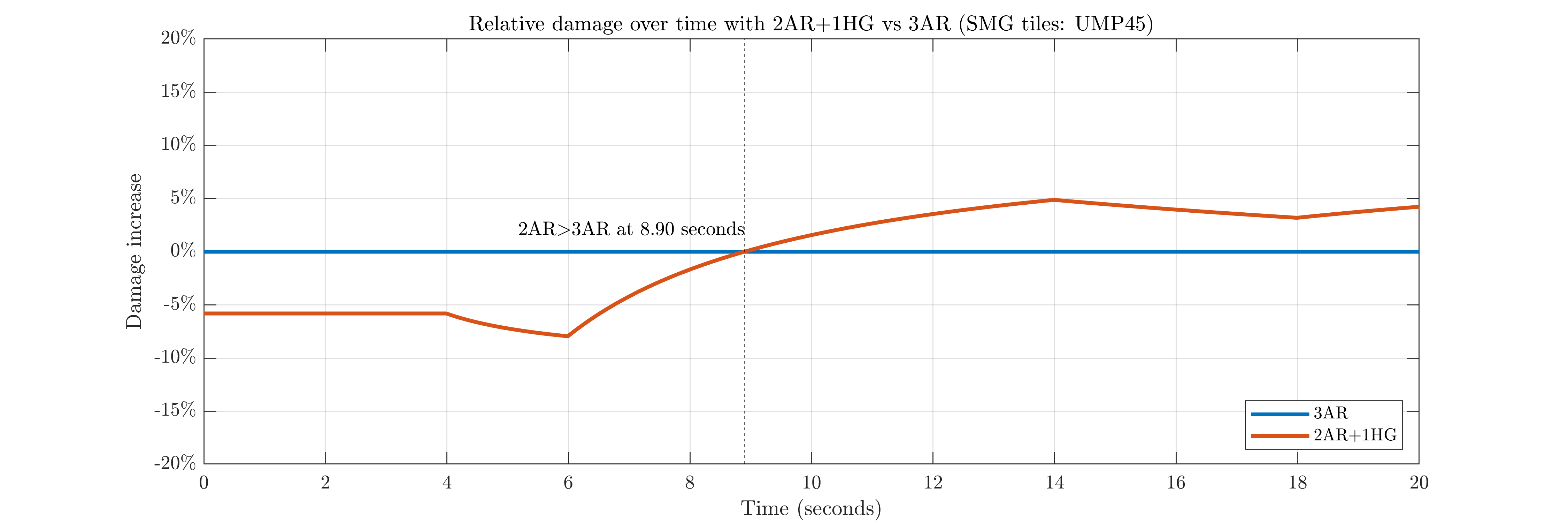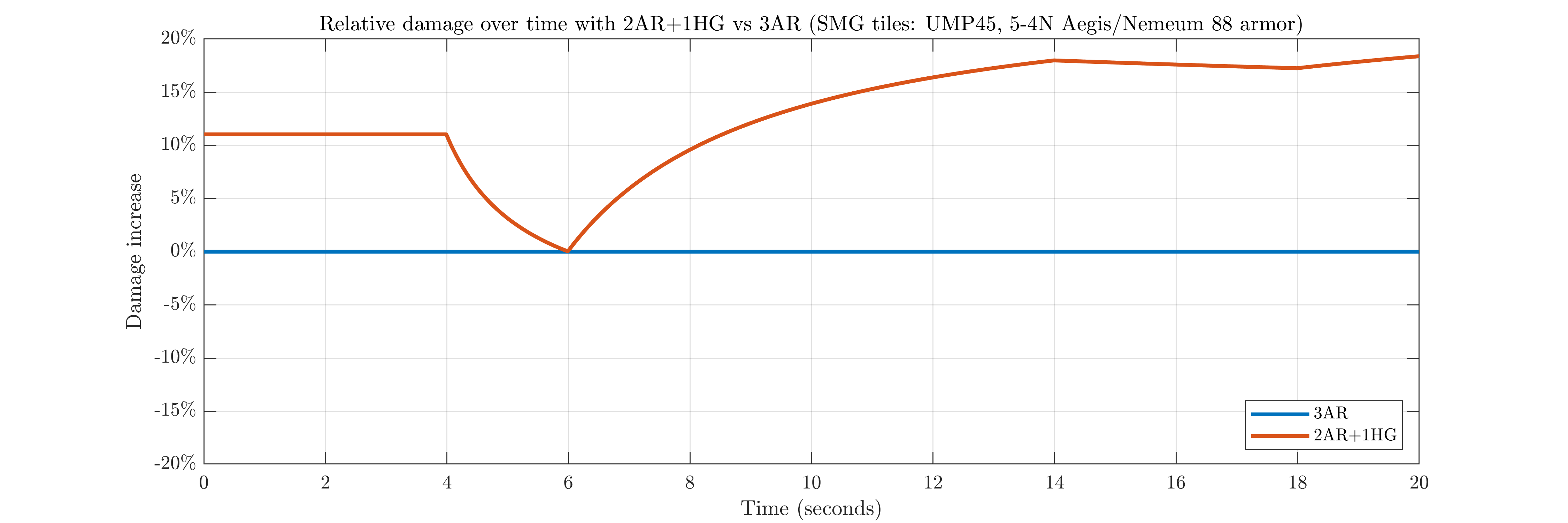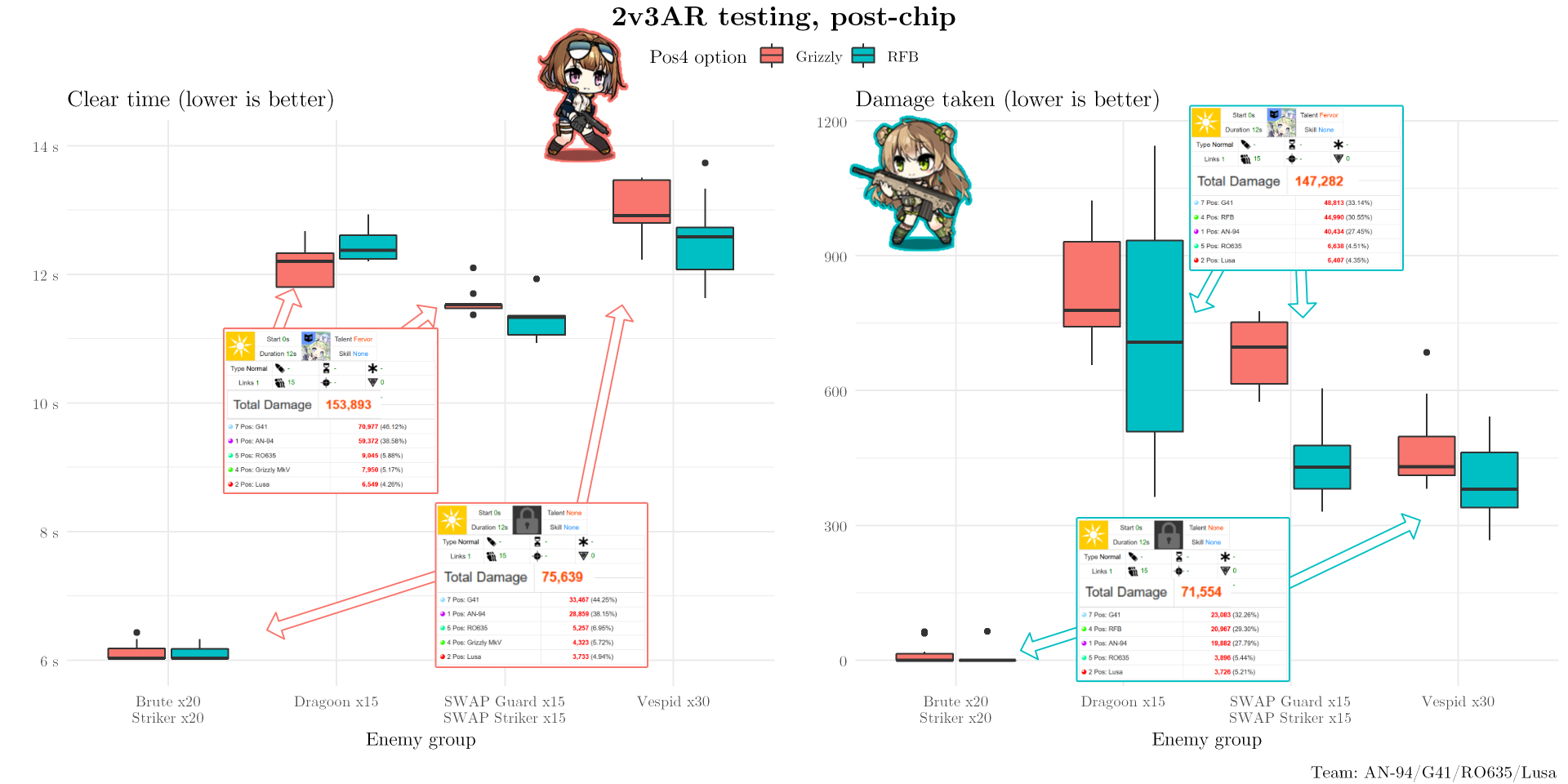Every starting player is typically recommended to use an ARSMG echelon with M4A1, AR-15, and Sopmod II (or some other third AR/RF) in the back plus two SMGs in front (most commonly, RO/UMP45+Vector/Skorpion). This is a great idea: these ARs are very strong and usable even in endgame content. M4A1 also provides excellent bonuses to the other ARs from her tiles.
But how do other 3AR2SMG teams perform at day? Should you switch the middle AR out for a HG? Handguns and ARs fundamentally do very different things in an echelon, so there's no absolute answer.
This is not a general guide for teambuilding or an introduction to the echelon type - for that, I recommend something like this excellent writeup, even if it's a bit old.
Theory#
Let's start by considering a very simplified echelon: 3 copies of G41 + UMP45 or 2 copies, UMP45, and Grizzly for the HG option. UMP45's damage is ignored as she will probably be kiting. The initial DPS with a handgun is lower - UMP45's tiles don't affect Grizzly and adding 30% damage tiles to two ARs is clearly worse than 100% of a new AR (setting aside some high armor scenario). With this model, it'll take about 9 seconds for the team with Grizzly to catch up in total damage dealt:

One important aspect of this chart is Grizzly's own damage contribution. If you don't have the HG fully equipped or don't consider her own DPS, the 2AR1HG setup has more difficulty competing. With no equipment on Grizzly, it drops to something like this. Suppressors and HP ammo are generally not recommended to craft for newer players (HV ammo/crit scopes/AP ammo/exos are higher priority), and an under-equipped handgun will hurt performance.
Stronger position 1/7 ARs or a stronger handgun may hasten the crossover point, while a stronger position 4 AR or weaker HG will push it back. Similar deal with SMG tiles - strong tiles like UMP45's favor 3AR, even more so if your offtank also covers position 4 (see an example here with Suomi only, or this one with JS 9 & UMP45 for tiles). Crit-oriented setups will also lower the relative damage contribution of a handgun - with a few tiles like UMP45's or JS 9's, ARs could be dealing 200%+ damage crits with every shot while most handguns only have a 40% crit rate with a maxed suppressor.
The increased FP is much more valuable than the third AR's DPS when looking at armor:

Exact values will vary based on how close your FP is to their armor with and without skills active.
These are all very theoretical values. A damage-buffing handgun like Grizzly, for example, may increase damage lost to overkill and link protection. ARs have tiles themselves, and some handguns will buff other things too (like accuracy or evasion). There are many other AR/SMG combinations that will produce different results.
(2021-12-22 update): The introduction of the #2 Processor chip changes the numbers here a little - higher per-AR DPS means the damage contribution of the HG is less significant, favoring 3AR backlines a bit more on paper. The above charts have been updated accordingly - the first chart, for example, went from a 7.7-second crossover point to a 8.9-second crossover.
To summarize: theoretically, 2AR1HG backlines generally have worse initial DPS but do better after 9-12 seconds compared to 3AR backlines. This will vary quite a bit with each setup and situation.
Next, I'll go over why we shouldn't trust these types of results or use them to guide your echelon building, particularly when comparing significantly different options.
Damage Simulators#
Combat effectiveness is a useless number that doesn't tell you how good a team is. Most of the issues with CE are not tied to how it is calculated - no matter how the formula is adjusted, you can never assign a single number to an echelon that represents its abilities in real combat, as you need different things for each battle. Using a damage simulator to get some "damage" number and compare teams with that falls into many of the same traps and cannot be used to accurately compare most echelons.
A few of the more relevant problems with damage simulator results: damage simulators generally assume a single infinite-health dummy with constant properties (evasion/armor), plus an optional link multiplier to apply to AOE attacks. There are no real fights in the game that work like this, and instead come with a whole host of mechanics simulators can't account for (to name a few: overkill, link protection, corpse whipping, (allied) evasion, kiting, taking damage, priority targets, killing enemies before they attack). Many dolls have skills that simulators cannot properly model, and the number of those is only increasing over time. Grenade and other AOE skills usually lead to massively inflated numbers. For more on this subject, see over here.
So, you should almost never pick your team based on which one is given a higher "DPS" by a simulator. In terms of 2AR+1HG vs 3AR backlines, there are a few matters of particular concern:
- HG tiles and skills will increase the theoretical DPS of your SMGs, but your maintank is probably moving constantly and won't get many shots off. They'll also lose links over time and contribute even less. A molotov offtank may deal lots of damage against swarms, in which case FP tiles on them are very useful. They also may do little damage against sparse/single-linked enemies, and FP tiles would be almost useless.
- 6-second HG skills will massively inflate the damage reported from non-Zas grenades. Whether or not this grenade hits that many targets and needs that damage buff to kill links is an entirely different matter. AP grenades, with their 15-16x multiplier, are easy to overkill with.
- Many handguns do not work here - ROF buffers will almost always lead to significant overcap (especially now that the #2 Chip is a thing), and others have defensive skills that contribute very little.
- ARSMG echelons are, in general, used for significantly shorter battles. Many common SF fights are over in 4-10 seconds, so a DPS advantage once you get to 8-12+ seconds won't show up much.
In practice, it's entirely possible for the trends a damage simulator predicts to entirely disappear or even reverse. Experimental results are not covered on this main page as there are simply too many variables involved in some sort of "general-use ARSMG" to get any concise, broadly applicable results. There also are not many good ways to test multiple sequential battles. If you do want to see some tests I've done for various situations, I've thrown them all on this extras page. In those tests, 3AR backlines usually outperformed 2AR1HG ones despite DPS simulators almost always assigning larger numbers to the 2AR1HG teams. Similar results can be seen over here, where AUG/Angelica/89 Shiki/Grizzly are compared as pos4 options and Grizzly was almost always the worst choice.
Another round, post chips if you still aren't convinced:

Even in the one case where Grizzly seemed to clear slightly faster (vs the 15 Dragoons), the team with RFB had a similar advantage with reduced damage taken. The Vespids are a homogeneous group so RFB's targeting should not be a factor and that team/timeframe put her at a ~5% simulator disadvantage, but she still did better by both metrics.
One interesting example here: coalition drills. The only objective with them is consistently clearing a single enemy wave while getting below the 20% threshold. DPS numbers would be more relevant here than elsewhere (as you don't need to worry about survivability/versatility), but other issues still crop up and alter teambuilding. You can't just try all reasonable doll combinations in a combat simulator and see which one gives the highest DPS by the threshold time. Against a dinergate swarm, for example, MGs often have enough FP to oneshot links so adding HG buffers doesn't improve their DPS. Those enemies can be difficult to clear consistently as MG targeting RNG can make several of them shoot the same dinergate and waste their bullets. How much a grenadier helps will depend dramatically on how many enemies are alive when their skill goes off and how densely packed they are. Echelons that do well in coalition drills will almost never work well elsewhere, for more typical content.
To summarize: damage simulator numbers are generally not a good way to evaluate and compare echelons. While 2AR1HG lineups tend to have bigger numbers on paper, it does not appear to translate into real performance in many scenarios. 3AR backlines can perform better even far past the supposed "crossover points" in the charts earlier.
General Recommendations#
Despite what the damage simulator numbers may indicate, 3AR backlines have a number of advantages over 2AR1HG backlines and will usually perform better, assuming reasonably-selected dolls in both cases. Damage simulator results are very misleading here. The differences are still not massive, and are unlikely to make-or-break a fight. Specific situations can still call for certain handguns.
I would tend to prefer an appropriate AR when:
- You will be fighting a variety of enemies and want your backline to cover more roles with their skills.
- You want early DPS/the battles are short (<~20 seconds). This covers most main story levels up to Chapter 10 or 11, when things become more RFHG-focused anyways.
- Extreme case: Orthrus. 3 ROF/multihit ARs will do far better than 2 ROF/multihit ARs plus a handgun.
- SWAP Dragoons are another especially good case for 3 AR backlines - breaking their shield early stops their 2x FP selfbuff and lets your tank survive much better.
- You have strong SMG tiles and/or crit damage aura.
- You are fighting larger or low-HP enemy groups.
- The AR's tiles are useful (e.g., 416 mods' FP on an offtank).
- You're using G36c mod, as her immortality duration improves for every AR/SMG in the echelon (or some other skill that factors in your AR count)
- Your grenadier's damage is sufficient to one-shot most mobs you're facing.
And I'd favor a strong FP-buffing HG when:
- Your AR options are limited, or you have one or two specific strong ARs you want to buff more. Looking beyond a single map clear, raising more HGs is likely to give you a better armory long-term.
- This can also apply when building a high-end ARSMG - some options like G11 mod are so far ahead most other ARs that a HG buffing her is significantly better than adding some less-extraordinary AR.
- You are expecting longer (20+ second) battles against tough (very high HP/link) enemies that don't need early DPS (bosses), and can't use a RFHG echelon.
- You will be going against armor, and can't use a RFHG/MGSG echelon.
- You are (primarily) fighting some enemy that targets your backline and can be manipulated favorably.
- Rodeleros are the easiest example - handguns move faster and cost less DPS to dodge their lasers with.
- This can be useful against Jaguars, but their targeting depends on skill bar order/acquire sequence so it's mostly only practical to manipulate in Theater/target practice. They also don't show up that much, especially in harder groups.
- Your HG offers particularly valuable tiles or a skill for a situation (e.g., Python's FP on Uzi to deal with ELID swarms or HS2000's echelon-wide shield for some AOE attack).
- Your equipment situation is dire. Packing your best pieces onto two ARs and buffing them with a HG will be better than trying to spread 2 HVs and 1 crit scope across 3 ARs.
- Your grenadier's damage a bit short of one-shotting most mobs you're facing.
"General use"/main story chapters will fall more into the first set of situations, so I would default to that (use 3AR echelons) and just keep an eye out for specific situations that may prefer a handgun instead. More complex/event situations are more likely to call for a HG. If you have a use for a FP or ROF selfbuffer, M4A1 or AUG/Angelica (respectively) are nice options for the middle. Just be careful not to use them only because their tiles buff ARs. At the same time, ARs are much less useful dolls to raise than HGs. A 3rd AR can be used in certain situations, if available, but you absolutely should not prioritize raising them for additional echelons over handguns or other doll types.
This gets into more general teambuilding ideas, but a few other things to keep in mind:
- Teams generally aren't built in isolation. Keep in mind what other echelons are needed and what your armory can provide. Putting all your best FP buffers in a few ARSMG echelons will make it harder to deploy effective RFHG/MGSG echelons.
- To save resources, don't use ARSMGs at all. Have you seen how much a SMG takes to resupply? Swapping one AR for a HG barely does anything. A few cheap echelon types that can be viable in various situations and will save you much more than 30/30 ammo/rations are:
- M4A1 mod+2 HGs
- 5 HG
- 1 AR or RF + 1-4 HGs
- <5 HG
- ARSMG echelons see limited use in the current meta. Don't think too hard about how to optimize them when you could be duping more Hanyangs/Grapes/P22s. HGs are more broadly useful dolls to raise.
- After you've built 1 ARSMG and 1 RFHG echelon, you can start to move away from thinking in terms of fixed teams. Raise useful dolls (1, 2) and build teams for each situation using what you have available.
- Not all these ideas translate directly to high-end content. If you're building exactly 1 ARSMG for a ranking map/challenging event map, G11 and 416 are solid candidates. Those 2 ARs are strong enough that you'd typically prefer to buff them more, instead of adding another DPS (M4's also likely to be in a separate team, here). But it's best to understand the basic rules before breaking them in specialized contexts.
To put it very concisely: 2AR1HG backlines are often claimed to be better than 3AR backlines as they produce higher numbers in a damage simulator. However, there are a number of reasons to believe the numbers with a HG are inflated, and in real tests 2AR1HG backlines fail to reproduce this supposed advantage. Therefore, unless you have some other particular reason to use a HG, a third AR has a decent chance of performing better.
This is all with respect to day battles. You'll need a handgun for vision in non-theater night battles no matter what, so that just becomes a matter of where you put the handgun (frontline or backline).
Bonus: why not 3RF2HG?#
It's commonly accepted that 2RF3HG echelons are better than 3RF2HG echelons. As usual, you can plug random teams into damage simulators and get random DPS numbers, which may favor either type depending on what dolls you put in. In most cases, 2RF3HG echelons will do better there. This has a bit more weight as simulator models of generic RFHG echelons (2 selfbuffing rifles + 3 buffing handguns) will be closer to real performance in many cases compared to generic ARSMG echelons as it's all direct-fire DPS. Even without that, there are a number of other reasons to prefer 2RF3HG echelons.
- Backline HGs (Stechkin, Python, etc) are strong and not being able to use them sucks. Rifles can also benefit from more of these than ARSMG echelons.
- Most people don't have that many copies of Px4/P22/Webley, so tile coverage is not great with only two handguns and ROF options are very limited (which will make larger enemy groups hard to deal with).
- You get another HG to kite and absorb damage with. Handguns don't last long so this is important.
- RFHG echelons (generally) see more use in long fights, allowing HG skills to activate. Their CDR tiles also let HG skills kick in faster.
There may also be some overkill/damage threshold-related ideas as described here, though I haven't looked into that much myself.